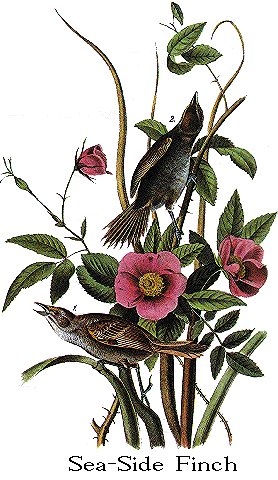
| Family XV. FRINGILLINAE. FINCHES. GENUS V. AMMODRAMUS, Swains. SHORE-FINCH. |
Next >> |

Family |
SEA-SIDE FINCH. [Seaside Sparrow (see also MacGillivray's Shore-Finch).] |
| Genus | AMMODRAMUS MARITIMUS, Wils. [Ammodramus maritimus.] |
The monotonous chirpings which one hears in almost every part of our
maritime salt-marshes, are produced by this bird and another nearly allied to
it. The Sea-side Finch may be seen at any hour of the day, during the months of
May and June, mounted on the tops of the rankest weeds which grow by the margins
of tide-waters along the greater portion of our Atlantic coast, whence it pours
forth with much emphasis the few notes of which its song is composed. When one
approaches it, it either seeks refuge amongst the grass, by descending along the
stalks and blades of the weeds, or flies off to a short distance, with a
continued flirting of its wings, then alights with a rapid descent, and runs off
with great nimbleness. I am inclined to believe that it rears two broods in the
season, as I have found birds of this species sitting on their eggs early in
May, and again in the beginning of July. The nest is placed so close to the
ground that one might suppose it partly sunk in it, although this is not
actually the case. It is composed of coarse grasses externally, and is lined
with finer kinds, but exhibits little regularity in its structure. The eggs are
from four to six, of an elongated oval form, greyish-white, freckled with brown
all over. The male and the female sit alternately, and will not fly off at the
sight of man, unless he attempts to catch them on the nest, when they skulk off
as if badly wounded. Many nests may be found in the space of a few acres of
these marshes, where the land is most elevated, and where small shrubs are seen.
They select these spots, because they are not liable to be overflowed by high
floods, and because there are accumulated about them drifted sand, masses of
sea-weed, and other castings of the sea, among which they find much food of the
kind which they seem to prefer. This consists of marine insects, small crabs
and snails, as well as the green sand beetle, portions of all of which I have
found in their stomach.
It is very difficult to shoot them unless when they are on wing, as their
movements while they run up and down the weeds are extremely rapid; but their
flight is so direct and level, that a good marksman can easily kill them before
they alight amongst the grass again. After the young are well grown, the whole
of these birds betake themselves to the ditches or sluices by which the
salt-marshes are intersected, fly along them, and there find abundant food.
They enter the larger holes of crabs, go into every crack and crevice of the
drying mud, and are then more difficult to be approached, as the edges of these
ditches are usually overgrown with taller and ranker sedges. Having one day
shot a number of these birds, merely for the sake of practice, I had them made
into a pie, which, however, could not be eaten, on account of its fishy savour.
The rose on which I have drawn these birds is found so near the sea, on
rather higher lands than the marshes, that I thought it as fit as any other
plant for the purpose, more especially as the Finches, when very high tides
overflow the marshes, take refuge in these higher grounds. It is sweetly
scented, and blooms from May to August. I have never met with it elsewhere than
on the small sea islands and along the coasts, where it grows in loose sandy
soil.
From Texas to Massachusetts along the shores of the Atlantic. Resident in
the Southern States. Abundant.
SEA-SIDE FINCH, Fringilla maritima, Wils. Amer. Orn., vol. iv. p. 68.
FRINGILLA MARITIMA, Bonap. Syn., p. 110.
SEA-SIDE FINCH, Fringilla maritima, Nutt. Man., vol. i. p. 505.
SEA-SIDE FINCH, Fringilla maritima, Aud. Orn. Biog., vol. i. p. 471.
Third and fourth quills longest, first and eighth equal; tail graduated;
upper parts brownish-grey, tinged with olivaceous, two faint longitudinal bands
of darker on the head; the feathers on the fore part of the back brown in the
centre; margin of the wing at the flexure light yellow, smaller wing-coverts and
outer webs of secondary coverts dull reddish-brown; quills and tail-feathers
dusky brown, edged with pale brownish-grey; a yellow band from the base of the
upper mandible over the eye, fainter behind; throat greyish-white, with a
longitudinal bluish-grey band on each side; lower part of neck, fore part of
breast and sides light bluish-grey, streaked with light olivaceous-brown; middle
of breast pale grey, abdomen white, lower tail coverts pale yellowish-brown,
with a central dusky streak.
Male, 8, 11.
THE CAROLINA ROSE.
ROSA CAROLINA, Pursch, Flor. Amer., p. 345.--ICOSANDRIA POLYGYNIA,
Linn.--ROSACEAE, Juss.
This beautiful species, which attains a height of five or six feet, is
generally characterized by its globose germens, which, with the peduncles, are
more or less hispid; its hairy petioles, slightly curved prickles, and
oblongo-lanceolate, acute, serrated leaflets, which are glaucous beneath. It
varies greatly, however, like many other species of the same genus.
| Next >> |